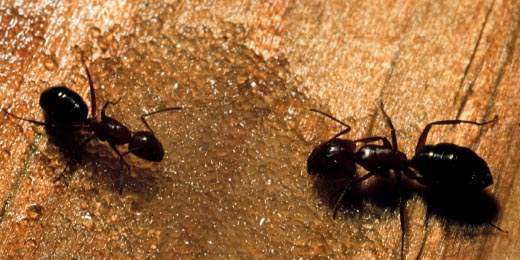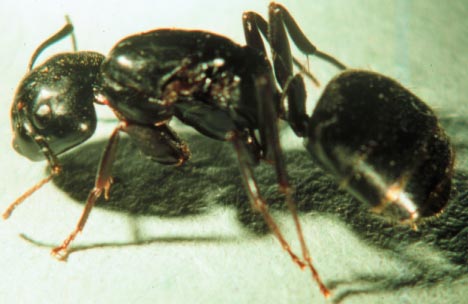
A carpenter ant, Camponotus sp. (Hymenoptera: Formicidae), workers at wet sugar. Photo by Drees.
Common Name: Carpenter ant
Scientific Name: Camponotus sp.
Order: Hymenoptera
Description: Fourteen species of carpenter ants occur in Texas. The largest species is the black carpenter ant, Camponotus pennsylvanicus (Fabricius) and is found primarily in wooded areas outdoors. Common indoor species, Camponotus rasilis Wheeler and C. sayi Emery, have workers that are dull red bodied with black abdomens. Worker ants range in size from 1/4 to 1/2-inch. They can be distinguished from most other large ant species because the top of the thorax is evenly convex and bears no spines. Also the attachment between the thorax and abdomen (pedicel) has but a single flattened segment.
Winged reproductive carpenter ants should not be confused with winged termites (Isoptera). Ants have elbowed antennae, distinctly veined wings of different sizes (large forewings and small hind wings) and a narrow portion of the body (waist) between the thorax and abdomen. The acrobat ants, Crematogaster sp., also occasionally nest in wood. These ants are much smaller and have a heart-shaped abdomen that is often held up over their bodies. They feed primarily on honeydew produced by aphids (Homoptera).
Life Cycle: Ants develop through several stages: eggs, larva, pupa and adult. Larva are legless and grub-like and pupae are a cream-colored to tan cocoon which are often mistakenly called “ant eggs.” Development from egg to worker ant occurs in about 2 months. Carpenter ants are social insects and live in colonies made of different forms of ants or “castes.” Mature colonies contain winged male and female forms (reproductives), sterile female workers of various sizes, and a wingless 9/16 inch long queen. Winged forms swarm during May through late July. The presence of 3/4 inch long winged forms in the home is an indication that structural damage may be occurring.

Black carpenter ant, Camponotus pennsylvanicus (Fabricius) (Hymenoptera: Formicidae), worker.
Photo by Drees.
Habitat, Food Source(s), Damage: Mouthparts are for chewing. These ants usually nest in dead wood, either outdoors in old stumps and dead parts of trees and around homes (in fences, fire wood, etc.) or indoors (between wood shingles, in siding, beams, joists, fascia boards, etc.). Ant colonies are often located in cracks and crevices between structural timbers, but the ants can also tunnel into structural wood to form nesting galleries. They often appear to prefer moist, decaying wood, wood with dry rot or old termite galleries. However, damage is often limited because these ants tunnel into wood only to form nests and do not eat wood. Galleries (nesting tunnels) produced by carpenter ants usually follow the grain of the wood and around the annual rings. Tunnel walls are clean and smooth. Nests can be located by searching for piles of sawdust-like wood scrapings (frass) underneath exit holes. These piles accumulate as the nests are excavated and usually also contain parts of dead colony members. Occasionally carpenter ants, particularly Camponotus rasilis Wheeler, nest under stones or in other non-wood cracks and crevices. Foraging worker ants leave the nest and seek sources of sweets and other foods such as decaying fruit, insects and sweet exudates from aphids or other sucking insects.
Pest Status: Although these ants can bite, they do not sting. Galleries excavated in wood by carpenter ants to produce nesting sites can weaken structures. Foraging worker ants in the home can be a nuisance.
Management: See Carpenter Ants.
For additional information, contact your local Texas AgriLife Extension agent or search for other state Extension offices.
Literature: Ebeling 1978; Hamman & Owens 1981. Owens 1983.